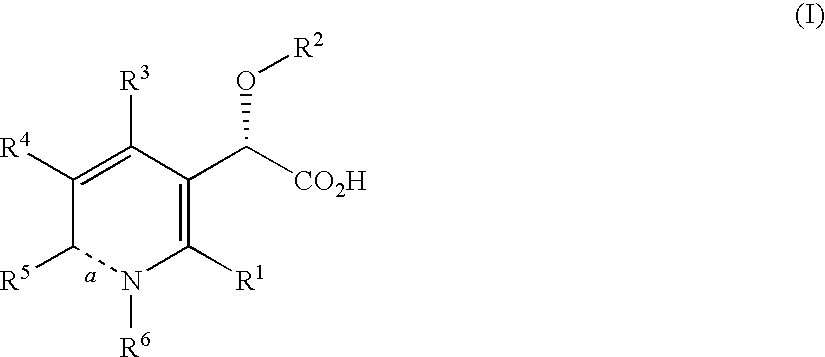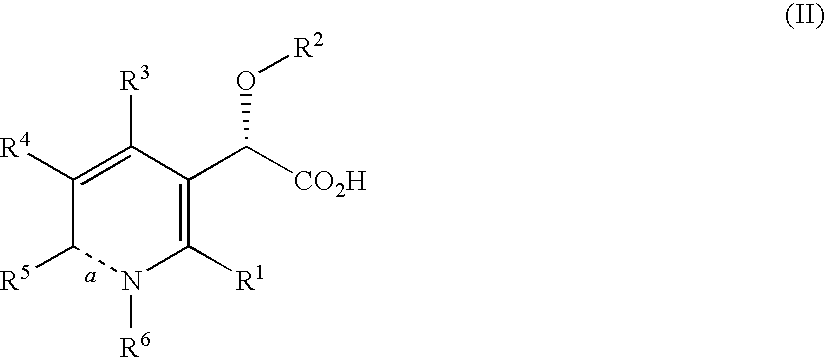Inhibitors of human immunodeficiency virus replication
a technology of human immunodeficiency virus and inhibitors, which is applied in the field of inhibiting the activity of hiv integrase and reducing the replication of hiv
- Summary
- Abstract
- Description
- Claims
- Application Information
AI Technical Summary
Benefits of technology
Problems solved by technology
Method used
Image
Examples
example 1
Synthesis of Compound 1029 (Table 1)
[0207]
Step 1:
[0208]A mixture of aldehyde 1a (5.85 g, 28.6 mmol; prepared according to Michel, P. and Ley, S. V. Synthesis 2003, 10, 1598-1602), phoshonate 1b (6.6 g, 34 mmol) and K2CO3 (8.8 g, 64 mmol) in MeOH (125 mL) is stirred overnight at RT. The mixture is concentrated nearly to dryness and the residue is partitioned between H2O (250 mL) and EtOAc (500 mL). The aqueous layer is washed with EtOAc (2×250 mL), and the combined organic layers are dried over anhydrous Na2SO4 and concentrated to give alkyne 1c.
Step 2:
[0209]A mixture of alkyne lc (5.0 g, 25 mmol) in TFA (35 mL) and water (3.6 mL) is stirred at RT for about 30 min. The mixture is concentrated under reduced pressure and the residue is purified by CombiFlash® Companion to give diol 1d.
Step 3:
[0210]A solution of diol 1d (1.2 g, 14 mmol) and Et3N (1.7 mL, 12 mmol) in DCM (80 mL) is cooled to 0° C. under N2. Trimethylacetyl chloride is added dropwise and the resulting mixture is allowed t...
example 2
Synthesis of Intermediate 2h
[0218]
Step 1:
[0219]To a solution of sodium ethoxide (1.48 L, 3.74 mol, 21% w / w in EtOH) at RT is added a solution of diethyl methylmalonate 2a (645 mL, 3.72 mol) in anhydrous PhMe (330 mL). The resulting solution is stirred for 30 min and a solution of ethyl 3-aminocrotonate 2b (485 mL, 3.71 mol) in anhydrous PhMe (490 mL) is added. The mixture is stirred at reflux for 39 h, EtOH (1-1.5 L) is removed by vacuum distillation, the mixture is cooled and water (1.6 L) is added. The mixture is stirred at 40° C. for ˜2 h, then is cooled and the phases are separated. The aqueous phase is washed with PhMe (2×50 mL) and then adjusted to pH 5-6 with conc. HCl. The solid is filtered and dried to afford dihydroxypyridine 2c.
Step 2:
[0220]To a mixture of dihydroxypyridine 2c (100 g, 0.718 mol) and DCM (800 mL) at ambient temperature is added dropwise Br2 (37 mL, 150 g, 0.72 mol) in DCM (550 mL) over 16 min. The resulting mixture is stirred at RT for 1 h and intermediate...
example 3
Synthesis of Intermediates 3g and 3h
[0226]
Step 1:
[0227]To a mixture of 2-chloro-6-fluoronitrobenzene 3a (6.62 g, 37.7 mmol) and LiOH.H2O (6.33 g, 151 mmol) in THF (45 mL) and water (65 mL) is added aqueous H2O2 (30%, 8.6 mL, 80.0 mmol). The mixture is sealed and is heated to 60° C. with rapid stirring. After 3 days, the mixture is cooled, added to half-saturated aqueous sodium thiosulfate (200 mL) and shaken vigorously in a separatory funnel. The mixture is acidified to pH<3 with 1 N HCl, extracted with EtOAc (500 mL) and washed with brine (400 mL). The combined extracts are dried over magnesium sulfate, filtered and evaporated to give phenol 3b.
Step 2:
[0228]To a mixture of phenol 3b (6.37 g, 36.7 mmol) and THF (100 mL) is added tin powder (17.4 g, 147 mmol) followed by 1 N HCl (220 mL, 220 mmol) and the mixture is stirred vigorously at RT for 16 h. The mixture is cooled to 0° C. and neutralized with 10 N NaOH (22 mL), and stirred vigorously for about 15 min. The mixture is filtered...
PUM
| Property | Measurement | Unit |
|---|---|---|
| w/w | aaaaa | aaaaa |
| wt % | aaaaa | aaaaa |
| time | aaaaa | aaaaa |
Abstract
Description
Claims
Application Information
 Login to View More
Login to View More - R&D
- Intellectual Property
- Life Sciences
- Materials
- Tech Scout
- Unparalleled Data Quality
- Higher Quality Content
- 60% Fewer Hallucinations
Browse by: Latest US Patents, China's latest patents, Technical Efficacy Thesaurus, Application Domain, Technology Topic, Popular Technical Reports.
© 2025 PatSnap. All rights reserved.Legal|Privacy policy|Modern Slavery Act Transparency Statement|Sitemap|About US| Contact US: help@patsnap.com



